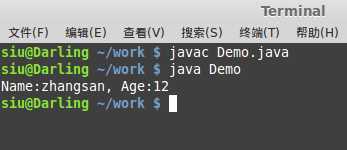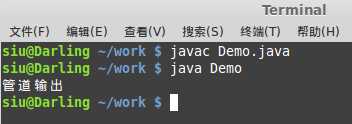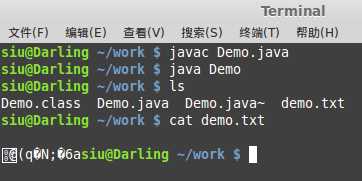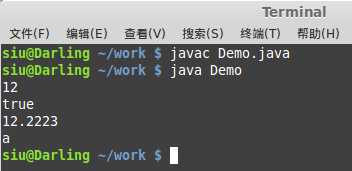I/O操做总结)
Posted
tags:
篇首语:本文由小常识网(cha138.com)小编为大家整理,主要介绍了I/O操做总结)相关的知识,希望对你有一定的参考价值。
前面已经把java io的主要操作讲完了
这一节我们来说说关于java io的其他内容
Serializable序列化
实例1:对象的序列化
|
1
2
3
4
5
6
7
8
9
10
11
12
13
14
15
16
17
18
19
20
21
22
23
24
25
26
27
28
29
30
31
32
33
34
35
36
37
38
39
40
41
42
43
44
45
46
47
48
49
50
51
|
import java.io.File;import java.io.FileOutputStream;import java.io.IOException;import java.io.ObjectOutputStream;import java.io.Serializable;@SuppressWarnings("serial")//一个类要想实现序列化则必须实现Serializable接口class Person implements Serializable { private String name; private int age; public Person(String name, int age) { this.name = name; this.age = age; } public String toString() { return "Name:" + this.name + ", Age:" + this.age; }}public class Demo { public static void main(String[] args) { String path = File.separator + "home" + File.separator + "siu" + File.separator + "work" + File.separator + "demo.txt"; Person p1 = new Person("zhangsan",12); Person p2 = new Person("lisi",14); //此处创建文件写入流的引用是要给ObjectOutputStream的构造函数玩儿 FileOutputStream fos = null; ObjectOutputStream oos = null; try { fos = new FileOutputStream(path); oos = new ObjectOutputStream(fos); //这里可以写入对象,也可以写入其他类型数据 oos.writeObject(p1); oos.writeObject(p2); } catch (IOException e) { e.printStackTrace(); } finally { try { oos.close(); } catch (IOException e) { e.printStackTrace(); } } }} |
所谓对象序列化就是把一个对象进行持久化存储,方便保留其属性
通俗点说,等于把一个对象从堆内存里边揪出来放到硬盘上
当然,如果你开心,你可以序列化其他东西,包括数组,基本数据类型等等
来看看内容,神马玩意儿这是……

实例2:对象的反序列化
|
1
2
3
4
5
6
7
8
9
10
11
12
13
14
15
16
17
18
19
20
21
22
23
24
25
26
27
28
29
30
31
32
33
34
35
36
37
38
39
40
|
import java.io.File;import java.io.FileInputStream;import java.io.IOException;import java.io.ObjectInputStream;public class Demo { public static void main(String[] args) { String path = File.separator + "home" + File.separator + "siu" + File.separator + "work" + File.separator + "demo.txt"; //好吧,这里代码写得着实有点长了,还要抛异常什么的 //如果你也看的烦,那就在主方法上抛吧,构造方法里用匿名对象就好了 //什么?别告诉我你不知道匿名对象 FileInputStream fis = null; ObjectInputStream ois = null; try { fis = new FileInputStream(path); ois = new ObjectInputStream(fis); //这里返回的其实是一个Object类对象 //因为我们已知它是个Person类对象 //所以,就地把它给向下转型了 Person p = (Person)ois.readObject(); System.out.println(p); //抛死你,烦烦烦~!!! } catch (IOException e) { e.printStackTrace(); } catch (ClassNotFoundException e) { e.printStackTrace(); } finally { try { //还是要记得关闭下流 ois.close(); } catch (IOException e) { e.printStackTrace(); } } }} |
你看,我们把一个对象存放在硬盘上是为了方便日后使用
现在用得着它了,自然得拿出来

管道流
实例3:线程的通信
|
1
2
3
4
5
6
7
8
9
10
11
12
13
14
15
16
17
18
19
20
21
22
23
24
25
26
27
28
29
30
31
32
33
34
35
36
37
38
39
40
41
42
43
44
45
46
47
48
49
50
51
52
53
54
55
56
57
58
59
60
61
62
63
64
65
66
67
68
69
70
71
72
73
74
75
76
77
78
79
80
81
82
83
84
85
86
87
88
|
import java.io.IOException;import java.io.PipedInputStream;import java.io.PipedOutputStream;//实现Runnable接口,实现一个读的线程class Read implements Runnable { private PipedInputStream in; //将需要读的管道流传入到构造函数中 public Read(PipedInputStream in) { this.in = in; } //实现读这一线程 public void run() { try { byte[] buf = new byte[1024]; int temp = 0; //循环读取 //read是一个阻塞方法,需要抛异常 //此处把打印流的代码也加入进来 //是因为如果没有读取到数据,那么打印的代码也无效 while((temp = in.read(buf)) != -1) { String str = new String(buf,0,temp); System.out.println(str); } } catch (IOException e) { //其实这里应抛出一个自定义异常的 //暂时我还没弄清楚 e.printStackTrace(); } finally { try { //我已经抛火了,这只是为了提醒自己异常很重要 in.close(); } catch (IOException e) { e.printStackTrace(); } } } }//这里实现一个写的类class Write implements Runnable { private PipedOutputStream out; //将管道输入流传进来 public Write(PipedOutputStream out) { this.out = out; } public void run() { try { //这里开始写出数据 out.write("管道输出".getBytes()); } catch (IOException e) { e.printStackTrace(); } finally { try { //其实应该可以把这个关闭方法写到上面那个try里边 //但是这样感觉怪怪的,逻辑不大对 out.close(); } catch (IOException e) { e.printStackTrace(); } } }}public class Demo { public static void main(String[] args) { PipedInputStream in = new PipedInputStream(); PipedOutputStream out = new PipedOutputStream(); try { //连接管道 in.connect(out); //创建对象,开启线程 //此处同样放进try...catch里面 //因为如果没有链接管道,下面操作无意义 Read r = new Read(in); Write w = new Write(out); //把已经实现好run方法的对象放入线程中执行 new Thread(r).start(); new Thread(w).start(); } catch (IOException e) { e.printStackTrace(); } }} |
好吧,废了那么大劲儿,就打印了这么一句话,异常抛弃来很烦,为了注重细节……

管道流也许很难理解,其实非也
我们知道,字节流和字符流都需要数组来进行流的中转
而管道流则直接串联两条流,一边发送数据,一边接收
然而,同时通信的的两种状态,如何才能确定发送和接收的一致性呢
那么,就需要用到线程,无论是接收方还是发送方先执行
总会造成一个线程的阻塞状态,从而等待另一方的数据传过来
总体而言,管道流的目的,也就是为了线程通信
此外,还有PipedReader和PipedWriter类,操作原理都一样,这里就不再赘述了
DataOutputStream和DataInputStream类
实例4:基本数据类型的写入
|
1
2
3
4
5
6
7
8
9
10
11
12
13
14
15
16
17
18
19
20
21
22
23
24
25
26
27
28
29
30
31
32
33
|
import java.io.DataOutputStream;import java.io.File;import java.io.FileOutputStream;import java.io.IOException;public class Demo { public static void main(String[] args) { String path = File.separator + "home" + File.separator + "siu" + File.separator + "work" + File.separator + "demo.txt"; DataOutputStream d = null; try { //此处需要传入一个OutputStream类的对象 d = new DataOutputStream(new FileOutputStream(path)); //开始写入基本数据类型 d.writeInt(12); d.writeBoolean(true); d.writeDouble(12.2223); d.writeChar(97); //刷新流 d.flush(); } catch (IOException e) { e.printStackTrace(); } finally { try { d.close(); } catch (IOException e) { e.printStackTrace(); } } }} |
此处我们并不能直观看懂内容,因为它采用字节流的方式操作,而不是字符流
我们只需要知道,此程序已经将基本数据类型写入到硬盘即可

实例5:基本数据类型的读取
|
1
2
3
4
5
6
7
8
9
10
11
12
13
14
15
16
17
18
19
20
21
22
23
24
25
26
27
28
29
30
|
import java.io.DataInputStream;import java.io.File;import java.io.FileInputStream;import java.io.IOException;public class Demo { public static void main(String[] args) { String path = File.separator + "home" + File.separator + "siu" + File.separator + "work" + File.separator + "demo.txt"; DataInputStream d = null; try { d = new DataInputStream(new FileInputStream(path)); //按存储顺序读取基本数据类型 System.out.println(d.readInt()); System.out.println(d.readBoolean()); System.out.println(d.readDouble()); System.out.println(d.readChar()); } catch (IOException e) { e.printStackTrace(); } finally { try { d.close(); } catch (IOException e) { e.printStackTrace(); } } }} |
这里要注意的是,一定要按照写入顺序读取,否则会发生数据的打印错误

以上是关于I/O操做总结)的主要内容,如果未能解决你的问题,请参考以下文章